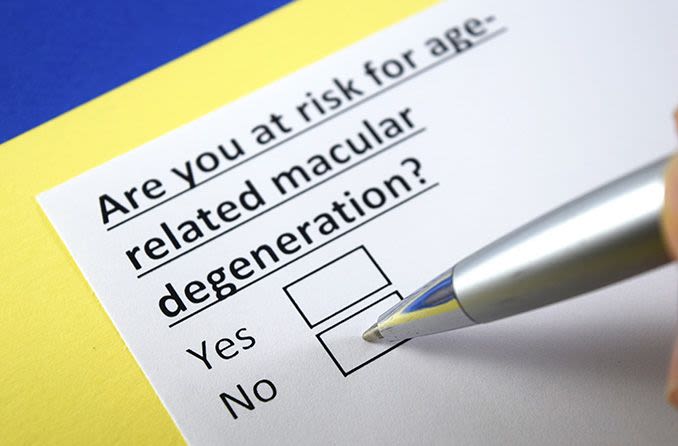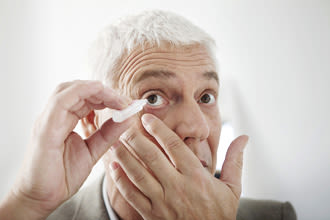Macular degeneration news

With AMD, keeping eye appointments slows progression
February 2020 — People being treated for age-related macular degeneration (AMD) who miss any appointments with their ophthalmologist have poorer visual outcomes, new research finds.
How much poorer?
The study’s lead author, Brian L. VanderBeek, MD, MPH, refers to the familiar Snellen eye chart used during exams to explain the findings.
“Essentially, there was a two-and-a-half line difference between patients who were compliant and those who were not. Functionally, that’s a pretty big difference,” says the professor of ophthalmology at the Scheie Eye Institute in Philadelphia.
“Depending on where you are on that chart to start, that could be the difference between being legal to drive and not driving at all, or being able to read the small print on a prescription bottle versus only being able to read large print in a newspaper.”
The study was conducted by researchers at the University of Pennsylvania’s Perelman School of Medicine. The research, published in JAMA Ophthalmology, found that missing just one appointment over a two-year period can result in a loss of visual acuity.
READ MORE: Keeping AMD appointments leads to better visual outcomes
Poor diet linked to late-stage AMD
January 2020 — An unhealthy diet that’s heavy on meat, fried foods and high-fat dairy isn’t only bad for your waistline and heart — it’s also bad for your eyes. People eating this typical Western diet are three times more likely to develop late-stage age-related macular degeneration (AMD), new research finds.
AMD causes people to slowly lose their central vision and it's the leading cause of irreversible vision loss among the elderly. Its sufferers may ultimately be unable to recognize faces, drive, read, watch TV, work on a computer or engage in other activities that require fine detail work.
People in the study who “reported frequently consuming unhealthy foods were more likely to develop vision-threatening, late-stage disease approximately 18 years later,” said senior author Amy Millen, PhD, associate chair of epidemiology and environmental health at the University of Buffalo, in a prepared statement.
Results of the long-term study were recently published in the British Journal of Ophthalmology.
UB researchers studied the occurrence of early and late AMD in participants in the Atherosclerosis Risk in Communities (ARIC) Study sponsored by the National Heart, Lung, and Blood Institute.
Researchers used data on 66 different foods that participants self-reported consuming between 1987 and 1995 to identify two dietary patterns designated as Western (unhealthy) and Prudent (healthy).
Previous research into diet and AMD focused on specific nutrients that appeared to have a protective effect (e.g., high-dose antioxidants). The University of Buffalo researchers instead looked at overall dietary patterns. “Our work provides additional evidence that diet matters,” Millen says.
AMD is a growing problem for a number of reasons besides diet. Experts believe that an increase in ultraviolet light, environmental pollutants, smoking, obesity, a family history of AMD and an aging population are all risk factors.
SEE RELATED: 11 steps to help prevent macular degeneration
Early AMD often goes undiagnosed because it has few symptoms. Advanced or late-stage AMD can result in atrophy or a buildup of new blood vessels in the macula, the central part of the retina that is responsible for visual acuity and color vision.
“When people start developing these changes, they will begin to notice visual symptoms. Their vision will start diminishing,” says Shruti Dighe, a lead author of the study.
Treatment for late-stage AMD is invasive and expensive, so it is best to catch the condition early and prevent its development, she adds.
In addition to eating a healthy diet, other recommendations for reducing your risk of developing AMD include:
— Don't smoke.
— Protect your eyes by wearing sunglasses with 100% UV protection and a wide-brimmed hat when outdoors.
— Get a comprehensive eye exam regularly with an eye care professional.
WHEN WAS YOUR LAST EYE EXAM? Find an eye doctor near you and schedule an appointment.
Gene therapy shows promise for wet AMD
October 2019 — More than a decade after the groundbreaking launch of anti-VEGF drugs for the treatment of wet age-related macular degeneration (AMD), gene therapy is being tested — and touted — as a potential “one-and-done” solution.
Anti-VEGF drugs aren’t perfect. It’s difficult for AMD patients — many of whom are elderly, living with other health conditions and/or dependent on others for transportation — to maintain the frequent visits to the ophthalmologist’s office for their eye injections, typically needed every four to six weeks.
With that in mind, researchers have sought to develop a treatment that is better suited to the patients they want to help. So far, gene therapy has shown the most promise: New data shows six patients with wet AMD have maintained their vision for six months after a single treatment of gene therapy.
“This is potentially paradigm shifting,” said lead researcher Dr. Szilárd Kiss, M.D., director of Clinical Research and chief of the Retina Service in the Department of Ophthalmology at Weill Cornell Medical College in New York City.
“It’s the next revolutionary leap in treating AMD,” Kiss said. “When you think about what is science fiction and what is science reality; gene therapy for AMD is becoming a clinical reality.”
The new gene therapy will start with one injection into the eye of genetic material that makes a molecule similar to anti-VEGF drug aflibercept (Eylea). Once it’s inside the eye, the DNA sequence makes the aflibercept on its own.
“Instead of taking a vile of aflibercept and injecting it into the eye, your eye makes the aflibercept,” Kiss explained. “You may need a booster once in a while, but this gene therapy could theoretically last a lifetime.”
Depending on clinical trials and regulatory reviews, Kiss expects gene therapy for wet AMD to be available in the next three to five years.
DO YOU HAVE AMD? Find an eye doctor near you and schedule an appointment to learn more about treatment options.
How to help avoid early vision loss from AMD? Never smoke
February 2015 — Need more ammunition to discourage your children and other loved ones from smoking? Try telling them this: Researchers in the Netherlands have found that, among people with advanced age-related macular degeneration (AMD), those who were active smokers or had previously been smokers and quit developed the eye disease significantly sooner than those who had never taken up the habit.

Know a young smoker? You might want to tell them that quitting could help prevent early vision loss.
The study included 275 patients with a known age at onset of neovascular ("wet") AMD. Past smokers and current smokers developed wet AMD an average of 4.9 years and 7.7 years earlier than patients with wet AMD who were lifelong nonsmokers.
The researchers also found that those with certain genetic risk factors for macular degeneration developed the disease 2.8 to 12.2 years earlier than a reference group without genetic risk factors for AMD, depending on the specific factors involved.
The study authors concluded that smoking and genetic risk factors both influence age of onset of wet AMD, and that making this information more widely known might influence people to take proactive measures to avoid vision loss from AMD.
The study was published online this month by JAMA Ophthalmology.
Study of eye risks from lifetime UV exposure reveals a surprise
November 2014 — Higher-than-average lifetime exposure to ambient ultraviolet radiation (UVR) increases the risk of cataracts and age-related macular degeneration (AMD) — but low lifetime UVR exposure might also increase a person's risk of early AMD.
Those are the somewhat surprising results of a new study published this month by Investigative Ophthalmology & Visual Science.

Yes, sunlight is beautiful, but you need to protect your eyes to avoid vision loss from macular degeneration and other eye diseases.
Researchers in France evaluated associations of lifetime exposure to ambient UV radiation with cataract surgery and diagnosis of macular degeneration among 963 residents of the Bordeaux region who were aged 73 or older. Estimated lifetime UV exposure was based on a survey of the participants and satellite-based data of ground UVR, and participants were then divided into three UVR exposure groups: lower quartile, intermediate quartiles, and upper quartile.
Study participants in the upper quartile of lifetime ambient UVR exposure had more than 50 percent greater odds of having had cataract surgery compared with participants in the intermediate quartiles of UVR exposure. Participants in this group also had more than 50 percent greater odds of being diagnosed with early AMD.
Surprisingly, participants in the lower quartile of UVR exposure also showed a significantly increased risk for early AMD compared with those with medium lifetime UV exposure.
The study authors concluded their research confirms results of earlier studies that show a high lifetime exposure to UV radiation increases the risk of cataracts and macular degeneration. The results of this study also suggest the risk for early AMD may be elevated among people who have a lower-than-medium exposure to UV rays throughout their lifetime. More research will be needed to confirm these latter results.
Blood pressure drugs linked to higher risk for AMD
July 2014 — Taking vasodilators and oral beta blockers for high blood pressure has been associated with a higher risk for developing age-related macular degeneration (AMD).

High blood pressure must be controlled for good health, but the medications may increase risk of eye disease.
Analysis of data from the long-term Beaver Dam Eye Study of nearly 5,000 people found that taking vasodilators such as Apresoline and Loniten seems to bring a 72 percent greater risk of early-stage AMD. In fact, among those taking a vasodilator medication, 19.1 percent developed the eye disease.
And taking oral beta blockers such as Tenormin and Lopressor seems to increase the risk of neovascular AMD by 71 percent.
The researchers suggested that further clinical studies be conducted to replicate the results and to find out why taking these medications increase AMD risk, before changing anyone's blood pressure medication.
A report of the analysis appeared online recently in the journal Ophthalmology.
Could eye drops soon replace injections for AMD treatment?
April 2014 — One in five people over age 75 suffer from age-related macular degeneration (AMD), and currently the only effective treatment for the advanced "wet" form of AMD involves injections of medicines called VEGF inhibitors into the eye. But that might change in the near future.

It may soon be possible to treat macular degeneration with eye drops rather than eye injections.
Researchers at University College London (U.K.) recently reported the results of animal studies that demonstrate it's possible to create formulations of tiny nano-particles loaded with the anti-VEGF drug Avastin and deliver significant concentrations of the drug to the back of the eye by means of topical eye drops.
Though additional studies are needed to see if the eye drops are effective at controlling wet AMD in humans, having a topical treatment would be welcome relief to people suffering from macular degeneration — especially those who are leery of having eye injections and are frightened by the procedure.
Topical treatment with medicated eye drops also would likely make AMD treatment significantly more affordable.
The study report includes data showing that the Avastin-loaded eye drops successfully deliver a therapeutic dose of the drug to the retina, where it stops leakage from retinal blood vessels and halts the formation of new abnormal blood vessels that are the hallmarks of wet AMD and lead to severe vision loss.
The study authors say the new technology has been patented by University College London's technology transfer company, UCL Business, and the researchers are seeking partners to accelerate commercial development of the treatment. The study report appeared in the March 2014 issue of the nanotechnology journal Small.
Rapid dark adaptation testing may be new way to detect AMD
March 2014 — It's been known for some time that age-related macular degeneration (AMD) significantly affects the ability to adapt to seeing in dimly lit environments — such as when entering a dark movie theater or re-adapting to seeing a dark roadway at night after encountering another vehicle with bright headlights.

Difficulty in adapting to dark environments can be tested more easily now with a new device called AdaptDx.
But traditional methods for measuring dark adaptation (DA) take at least 30 minutes or longer to administer, making them impractical as a diagnostic tool during a routine eye exam.
Recently, researchers at Penn State College of Medicine tested a new, rapid method for measuring dark adaptation as a way to quickly detect AMD. They used a testing device called AdaptDx, which is designed to measure DA in 6.5 minutes or less. Normal DA was found in 19 of 21 of healthy subjects, and abnormal DA was found in 115 of 127 AMD patients, giving the device a diagnostic sensitivity of 90.6 percent and a specificity of 90.5 percent.
The study authors concluded that the performance of the AdaptDx testing device compares favorably with long-duration research methods for the measurement of dark adaptation and direct examination of the eye performed by a retina specialist, and therefore that this rapid dark adaptation test is useful for the detection of AMD.
The study was published online in February by Investigative Ophthalmology & Visual Science.
Page published on Thursday, February 28, 2019




